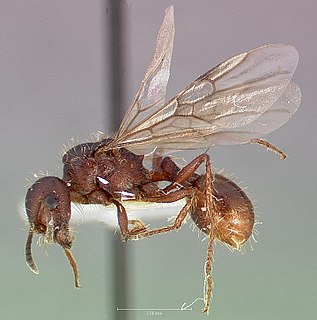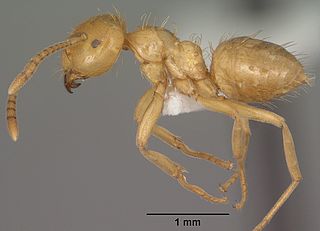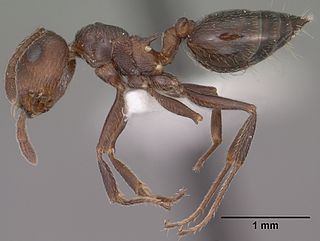
Convolvulaceae, known commonly as the bindweed or morning glory family, is a family of about 60 genera and more than 1,650 species of mostly herbaceous vines, but also trees, shrubs and herbs, and also including the sweet potato and a few other food tubers.
Menidia is a genus of Neotropical silversides native to freshwater, brackish and marine habitats along the Atlantic and Gulf of Mexico coasts of North America, ranging from the Gulf of Saint Lawrence in Canada to the Yucatán Peninsula in Mexico. The species M. clarkhubbsi, an all-female species, reproduces asexually.

Acacia colei is a perennial bush or tree native to northern Australia and southern Asia. A common name for it is Cole's wattle. Acacia colei blooms from May through September and the flowers are bright yellow.

Pogonomyrmex colei is a species of ant in the subfamily Myrmicinae. It is native to the United States.

Stenochironomus is a genus of European non-biting midges in the subfamily Chironominae of the bloodworm family Chironomidae.

Istiblennius is a genus of combtooth blennies found in the Pacific and Indian Oceans. The generic name is a compound noun composed of istio the Greek for "sail", referring to the high dorsal fin of the type species, Istiblennius muelleri, and blennius which is derived from a word for "mucus" and refers to the scaleless bodies that characterise the Blenniidae.
Istiblennius colei is a species of combtooth blenny found in the western Pacific Ocean, around the Philippines. Males of this species can reach a maximum of 11.8 cm (4.6 in) SL, while females reach a maximum of 10.3 cm (4.1 in) SL. The specific name of this blenny honours Howard I. Cole (1892-1966) who was the Chief Chemist for the Philippine Health Service at the leper colony on Culion Island, Philippines, which is the type locality.

Pogonomyrmex rugosus, or rough harvester ant, is a species of harvester ant in the subfamily Myrmicinae which is endemic to the southwestern United States, specifically New Mexico and southern Colorado.

Lasius colei is a species of ant belonging to the genus Lasius, formerly a part of the genus Acanthomyops. Described in 1968 by Wing, the species is native to the United States.

Crematogaster colei is a species of ant in tribe Crematogastrini. It was described by Buren in 1968.
Stenochironomus macateei is a species of midge in the family Chironomidae.
Cyclotelus is a genus of stiletto flies in the family Therevidae. There are more than 20 described species in Cyclotelus.
Stenochironomus woodi is a species of midge in the family Chironomidae.
Stichopogon colei is a species of robber flies, insects in the family Asilidae.

Stenochironomus hilaris is a species of midge in the family Chironomidae.

Sitobion is a genus of aphids in the family Aphididae. There are more than 80 described species in Sitobion.
Stenochironomus pulchripennis is a species of midge in the family Chironomidae.
Stenochironomus poecilopterus is a species of midge in the family Chironomidae.
Mexiweckelia is a genus of amphipods in the family Hadziidae. There are at least three described species in Mexiweckelia.

Ixora chinensis, commonly known as Chinese ixora, is a species of plant of the genus Ixora.









